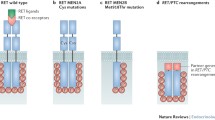Abstract
A high prevalence of RET rearrangements is found in papillary thyroid carcinomas (PTC) of children from Belarus after the Chernobyl reactor accident. The ELE/RET rearrangement (PTC3) is prevailing. Aberrant types of ELE/RET rearrangement have been found with a truncated ELE1 gene: As compared with the common form (PTC3r1) one aberrant type is shorter by one 144 bp exon (PTC3r2) (three cases); in the second atypic form (PTC3r3) the ELE1 part is 18 bp shorter than in PTC3r1. In agreement with the observation that the oncogenic RET is generated by a paracentric inversion at chromosome 10, we found not only ELE/RET, but also RET/ELE transcripts in these tumors. Sequencing of the breakpoint regions at the genomic DNA level revealed DNA modifications that might be relevant for illegitimate recombination after DNA doublestrand breaks. The high prevalence of ELE/RET rearrangements and various subtypes appears to be typical for radiation-induced thyroid carcinomas of children after the Chernobyl reactor accident.
Similar content being viewed by others
Author information
Authors and Affiliations
Rights and permissions
About this article
Cite this article
Klugbauer, S., Demidchik, E., Lengfelder, E. et al. Molecular analysis of new subtypes of ELE/RET rearrangements, their reciprocal transcripts and breakpoints in papillary thyroid carcinomas of children after Chernobyl. Oncogene 16, 671–675 (1998). https://doi.org/10.1038/sj.onc.1201526
Received:
Revised:
Accepted:
Published:
Issue Date:
DOI: https://doi.org/10.1038/sj.onc.1201526
- Springer Nature Limited
Keywords
This article is cited by
-
Targeting RET-driven cancers: lessons from evolving preclinical and clinical landscapes
Nature Reviews Clinical Oncology (2018)
-
A comprehensive overview of the role of the RET proto-oncogene in thyroid carcinoma
Nature Reviews Endocrinology (2016)
-
Current Standards in Treatment of Radioiodine Refractory Thyroid Cancer
Current Treatment Options in Oncology (2016)
-
Molecular pathogenesis and mechanisms of thyroid cancer
Nature Reviews Cancer (2013)
-
Radiation-induced thyroid cancer: What we have learned from Chernobyl
Endocrine Pathology (2006)




